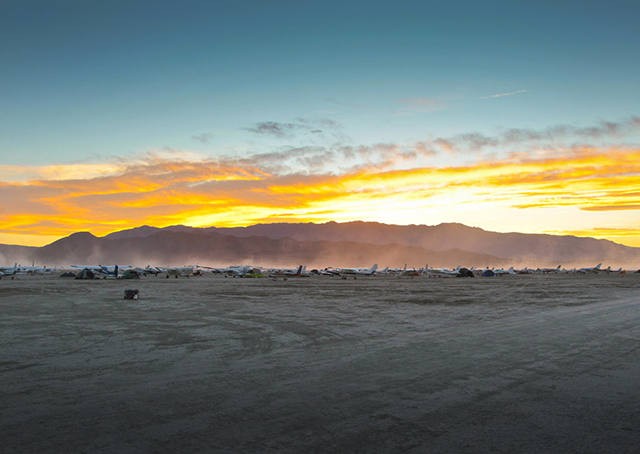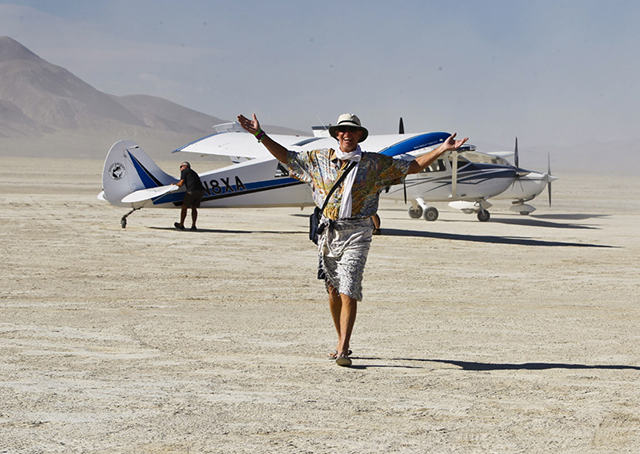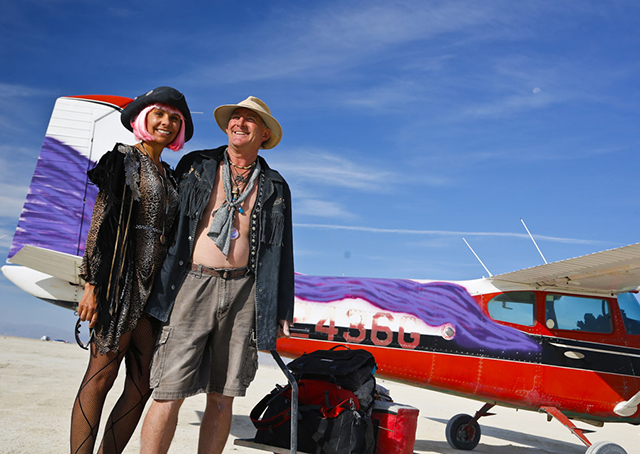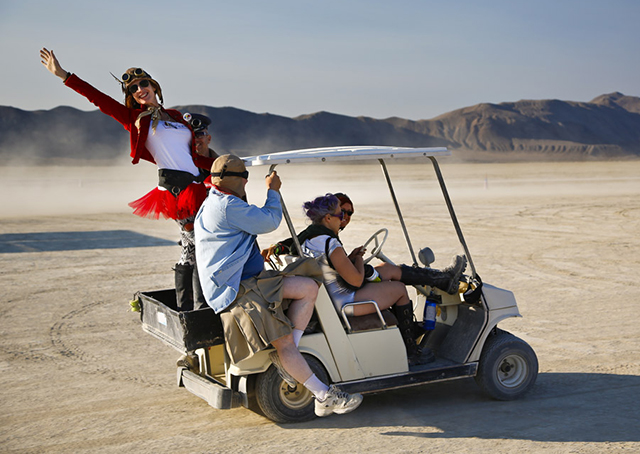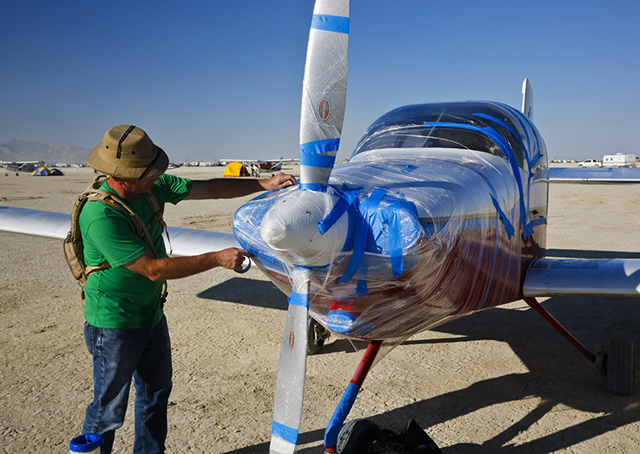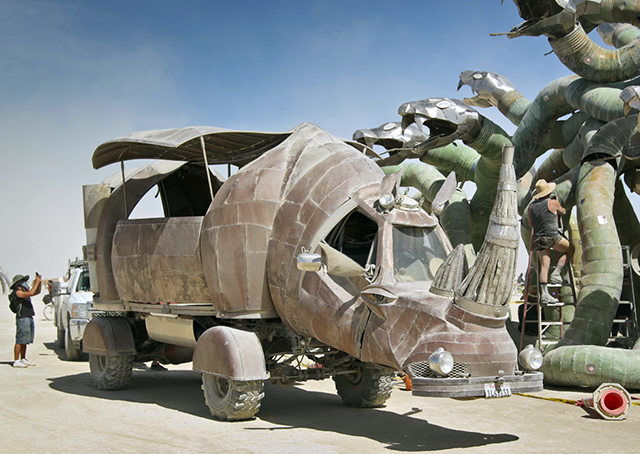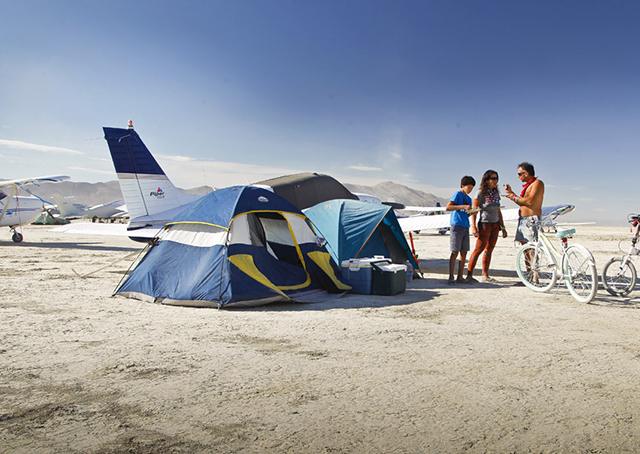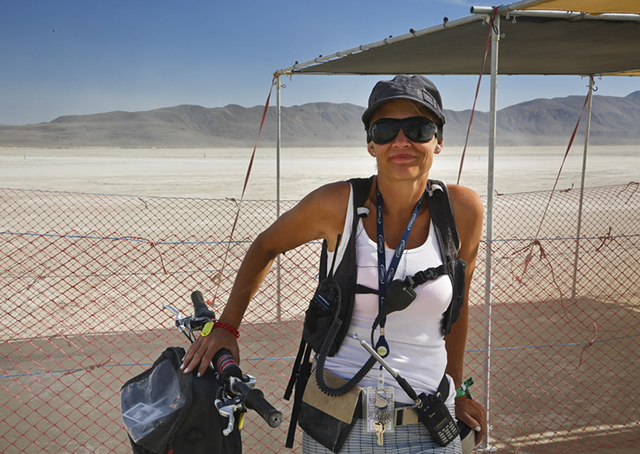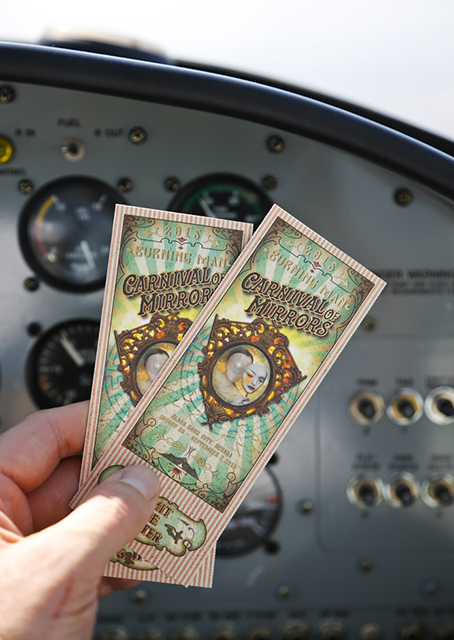Burning Man airport appears, disappears without a trace
Flying to Nevada desert festival has challenges
The semi-circular speck on the desert floor could be a mirage.
At a distance of 20 nautical miles, it's visible one moment, then partially obscured by shifting plumes of wind-driven dust the next. Jarring turbulence over the mountains of northern Nevada and late-afternoon glare don’t make spotting our destination any easier. But at a distance of 10 miles, the distinctive outline of Black Rock City comes sharply into focus—and our aircraft radio lets us know of charter King Airs, Caravans, and other general aviation aircraft coming and going at an airport that, for this hectic week, is quite unlike any other on Earth.
Black Rock City Municipal Airport (88NV) exists for one purpose: to support the massive counter-culture Burning Man festival which draws about 70,000 people to this inhospitable dry lake bed for a week of exuberant, over-the-top partying that culminates in the fiery destruction of a series of massive wooden art structures. Then the airport, just like Burning Man itself, disappears without a trace—only to reconstitute itself in even greater extravagance the following year.
Making 88NV work for the roughly 120 general aviation pilots who fly in and camp during the event, as well as more than a dozen Part 135 charter operators whose mostly turboprop fleets make about 500 arrivals and departures, and the skydiving crews who drop scores of parachute jumpers, depends on an international crew of volunteer "burners." Some, like "Air Commander" Sheila "Avi8rix" McCombe, a Canadian national who works as an air traffic controller in Dubai, are aviation professionals with decades of hands-on experience. Others have no formal aviation training but years of on-the-job experience and a deep devotion to the event.
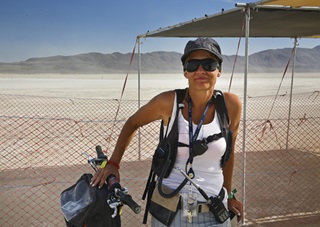
"This is a real airport that only exists because of the hard work of volunteers who love aviation, art, and self-expression," said McCombe, 51, who covers the airport's many acres on an electric scooter. "We're like-minded people who put in incalculable numbers of volunteer hours throughout the year. Then we come out here, band together, and overcome obstacles."
And there are many obstacles.
Extreme heat commonly raises density altitudes at 88NV to more than twice its actual 3,900-foot elevation. Strong winds create dusty whiteouts almost every afternoon. Even small amounts of rain can turn the powdery, talcum-like, alkaline surface into a pasty, impassible goo. On the regulatory side, the airport must comply with myriad regulations from both the FAA and the federal Bureau of Land Management, the agency that manages the federal land on which the event takes place. (Officials from both agencies are there during the festival week.)
It's about freedom
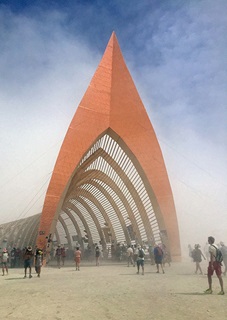
Burning Man is all about individual freedom—but flying into 88NV requires reading and agreeing to an eye-glazing 32 pages of airport rules. There's an online manifest to fill out, a 30-question online test to take and pass (minimum acceptable score: 90 percent), event tickets (which start at $390 each) to buy, and $40 cash to hand over upon arrival.
AOPA Photographer Chris Rose and I met all the pre-arrival requirements, and we also agreed to an incredibly restrictive set of media credential requirements. So, after a 2.5-hour flight from Salt Lake City in an RV-10, I felt thoroughly prepared when I checked in on the multi-com frequency (122.9 MHz) and reported our intention to land—along with the added proviso that we had the required "documents on board."
A gravelly voiced airport "Uni-commander" (short for “Unicom Commander”) monitoring the frequency quickly granted that permission.
As we approached the airport, however, I failed to spot the "Frog Pond" reporting point, or either of the two runways (25 Left for landing, and 25 Right for takeoff). I did see an actual pond to the west and turned in that direction. But based on the pond's position relative to Black Rock City, I soon realized that it couldn't be the Frog Pond.
Just then a departing King Air began its takeoff roll, kicking up a 100-foot tall rooster tail of dust on Runway 25 Right. I entered the pattern on a left crosswind and immediately ran afoul of authorities who instructed me to meet with "Tazz" after landing.
Rose, who had been reading up Burning Man and its 10 "core principles," chided me for testing the "radical inclusion" concept before we'd even touched down at the event.
"You're already a pariah," he said. "That didn’t take long."
We touch down on the unpaved but surprisingly smooth arrival runway using the soft-field no-braking technique recommended by the organizers, roll to the end, and call the "Ramp Dog" for a place to tie down and camp. We're told to pick any open spot among the 80 or so airplanes already tied down.
I'm embarrassed by my arrival blunder, but my priority once we shut down is protecting our airplane from the elements. I brought sheets of plastic to cover every bit of the exterior, as well masking tape for every vent, seam, and fairing, and cowl plugs to block the air intakes.
Squeeze Box and Frog Pond
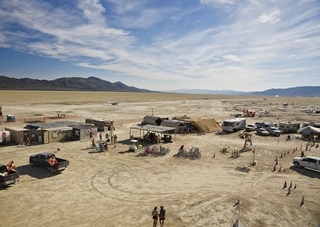 It takes more than an hour to secure the airplane to my satisfaction, and during that time I imagine Tazz is seething, probably upping the severity of the chewing out I'm about to receive. But even though I'm anxious to get the unpleasant conversation over with, my first priority is our airplane.
It takes more than an hour to secure the airplane to my satisfaction, and during that time I imagine Tazz is seething, probably upping the severity of the chewing out I'm about to receive. But even though I'm anxious to get the unpleasant conversation over with, my first priority is our airplane.
Rose and I are just about finished when Michael "Squeeze Box" Kovach-Long, an even higher-ranking "Deputy Air Commander," pays us a visit.
He's a wiry guy, dressed incongruously in desert camouflage and a high-visibility vest. He's wearing a floppy desert hat anchored by a nape strap cinched below his salt-and-pepper beard, and his expression is masked by dark sunglasses. I start our talk with a confession.
"Sorry about screwing up the arrival," I offer. "I misidentified the Frog Pond, and things just went downhill from there."
Kovach-Long points to a gap in the mountains to the southeast.
"The Frog Pond is in line with that saddle," he said. "Don't feel bad about missing it. It’s not like this is the first time that’s ever happened. We're all learning out here, and I know you won't make that mistake again. No harm done—and have a good burn."
I had been prepared for a verbal battle, but Kovach-Long's summation was on point, effective, and completely disarming. Score one for radical inclusion.
Then, looking at our RV-10 covered in Saran Wrap and sealed with blue tape, Kovach-Long said he was impressed. No other airplanes on the dusty ramp were so completely mummified. Our airplane would have looked right at home among the shrink-wrapped Cold War jets at the nearby boneyards.
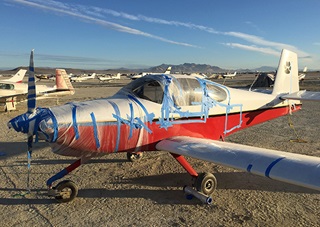
"Whatever else happens here this week," he said, "at least you know your airplane isn't going to pick up any STDs."
We chuckle at the mental image, but I've got another purpose to fulfill here this week that has nothing to do with art or frivolity. There's a special item tucked safely away in a manila envelope that I've kept in my possession all the way from my Maryland home—and I’ve promised to deliver it here. Now that we’re on the ground at 88NV, I'm within walking distance of its ultimate destination.
Special delivery
Every arriving aircraft is met on the ramp by a pair of "Interceptors."
Colorfully dressed in cowboy boots, bikini bottoms, leather vests, and aviator shades, these mostly female Interceptors are here to prevent unauthorized (meaning unpaid) visitors. They match the names of the new arrivals to the manifest, initial it, and then radio the information to the "Passport Office."
The Interceptors also, quite helpfully, transport our gear about 300 yards to the airport office in the back of their golf cart.
Rose and I walk over to the airport terminal, a brightly painted wood structure, for processing. Step one: Hand over $40 (cash). Step two: Show your initialed manifest. Step three: Present your event tickets for scanning. Step four: Get a faux-TSA interrogation.
This involves stepping alone into a windowless, dirt-floor room, and being asked pointed (and pointless) questions by a pair of outlandishly outfitted greeters. After a minute or two of banter, they invite you to commune with the dirt by rolling on the ground and making a "dust angel."
Then each visitor is handed a hammer and told to bang an empty metal cylinder to announce their arrival. (The hammer strikes start slowly on Monday and Tuesday and accelerate during the week as the number of arrivals swells.)
Rose and I set up our tents in the Airport Campground on the outer fringe of Black Rock City just before dark. The place is known as a relatively quiet suburb more than a mile from the rollicking, rave-all-night heart of the packed city. But that's not to say it's silent.
Fancifully decorated "art cars" come by at all hours blaring techno music from massive speakers. Other tunes are blasts from the distant past. Neil Diamond? Donna Summer? Elton John? An art car that serves as a moving pole-dance stage stops a few feet from my tent while performers act out the Divinyls' 1990 standard, I Touch Myself. A tricked out convertible plays the Bob Dylan anthem with the fitting refrain, "Everybody Must Get Stoned" (although, truthfully, the smell of marijuana is less prevalent in Black Rock City than downtown Denver).
Foam earplugs were powerless against the high-decibel onslaught.
I'm exhausted from the day's travels and turn in early. But a violent, tent-shaking wind comes up suddenly that night and threatens to rip the 6-inch stakes from the parched ground. Dust permeates my tent, and the next morning it's as filthy inside as out.
Everyone wears goggles and face covers during the wind storms, but many burners (Rose and I included) are afflicted with the same deep cough. And we quickly discover that human ears are an ideal shape for collecting dust and dirt.
There are no showers, so baby wipes are the next-best thing.
I'm up early to check on the airplane, and I'm relieved to find that the plastic wrap has protected it well from the elements. I add some tape to replace a few strips that have peeled back or disappeared, and plan to keep it up as often as necessary.
I wolf down a quick breakfast, then return to my tent, dust off the manila envelope, and start walking to the Black Rock City center to hand it over. There is a euphemistically named "playa" there, a word that in Spanish means beach, but here it's a vast, open expanse where the most intense partying happens alongside the grandest art structures.
At the far end of the playa is the "Temple," the grandest structure of all. It will be torched on the last night of the event, and when it burns, it will take with it thousands of letters, pictures, dolls, and other mementos attendees place inside for friends and family members who have passed away. Unlike the rampant cheering, dancing, and yelling that characterizes the other peak moments during the week, the "temple burn" is a somber, silent, reflective time.
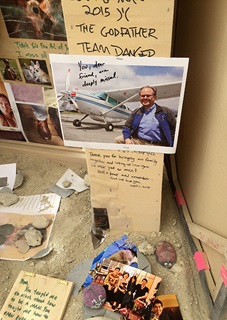
I bring a photo of John Kounis, co-founder of Pilot Getaways magazine, who died suddenly in July at age 51. Kounis was an aviation adventurer, friend, and inspiration. The photo, taken by AOPA Senior Photographer Mike Fizer, shows him smiling mischievously next to his favorite airplane, a Cessna 185 Skywagon.
Inside the temple, the walls are already filled with poignant messages of love and loss. I staple my friend's photo to a wall that, among other things, also holds a pair of pink baby booties and a series of messages from two heartbroken parents to their departed child.
When I step outside, billowing clouds of dust have reduced visibility to about 10 feet. I cover my face with the now empty envelope and, with the aid of a compass, walk south-southeast across the playa and toward the airport. It's roughly three miles away, but in these conditions, it’s not going to be easy to find.
After about one mile, I come to the "Esplanade," the city's innermost circular street, the place burners go to see and be seen. There, I wait several minutes to cross because there's a seemingly endless procession of naked bicyclists.
Next, I locate the street that leads to the airport. I’m tired, thirsty, and my eyes burn, but at least I’m not lost. I pass a camp in which there’s an elevated stage and two people sitting in chairs with microphones. Their purpose, according to a nearby sign, is to dispense compliments to passersby.
“You have a really purposeful stride!” one of them tells me.
“Yeah,” the other says. “You look like you’re on a mission!”
Thanks for noticing.
Colorful pilots
The airplanes tied down on the ramp at Black Rock City are typical of those at any GA airport. They range from two-seat trainers (a Cessna 152 and a Diamond Katana) to twins (Cessna 310s and one 340) and turboprops (two Pilatus PC-12s, a Kodiak, and a Cessna Caravan). Cessna 182s are the most numerous, followed by Bonanzas and Cirrus SR22s. Backcountry airplanes are well represented with Cessna 170s, 180s, and 185s, a couple Super Cubs, and a Pacer. Experimentals are there, too, with the RV series the most numerous, as well as a Kit Fox, and two Air Creation trikes.
Two jets, a CJ1, and a Lear 35, land during the event, drop off passengers, and depart in billowing clouds of dust.
But as standard as the airplanes tend to be, the pilots of Burning Man are a conspicuously colorful and generous bunch. They enthusiastically embrace the Burning Man ideal of a "gifting" economy in which people give things away with no expectation of receiving anything in return. It's not barter. They just give. And the thing pilots like to give most is airplane rides.
There's a tent at the airport where pilots offering rides mix with attendees who want to fly, and airport officials have set up a series of routes for scenic flights for pilots to fly (clockwise) around the city with altitudes dependent on airspeed. The routes also contain mandatory reporting points—and the operations runs smoothly.
"It would have been simple and easy to shut down the rides as the airport grew—but rides are an important part of the spirit of this place,” said Avi8rix, the Air Commander. “For many of the riders, rides are the highlight of their Burning Man experience. They’re also important to the pilots. A lot of them are serial gifters."
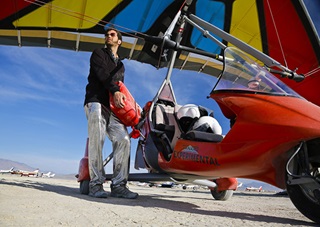
One of the trike pilots, Jake McGuire, planned to give 100 rides at this year's event. That meant flying his aircraft over the Sierra-Nevada mountains from his home airport in Lodi, California, and arranging for friends to transport fuel to the event. (There is no fuel for sale at 88NV.)
McGuire, a tall, lanky, dark-haired pilot with mutton-chop sideburns that make him resemble a young Burt Rutan, said providing rides allows him to contribute to the event.
"I can't think of any other gift that I can give here that's more memorable or more personal," he said. "I put a lot into it, and I get even more out of it."
Another pilot, Dave “Purple Haze” Barrett, flies passengers all day long in a purple, former Civil Air Patrol Cessna 182 that he keeps especially for Burning Man.
"I own another 182 that I use for business and personal transportation," said Barrett, who lives in Reno, Nevada. "This one is a good playa plane. It's perfect for gifting rides—and leaving it outside doesn't bother me. I'll give it a thorough cleaning when it gets home."
Ramona "SkyChick" Cox, was among the first pilots to fly to Burning Man in 1996. At that time, 88NV didn't exist, so she simply landed her Cessna 206 in the desert by a group of tents. All she knew about the event at the time was that it was “a costume party in the desert,” and its approximate latitude and longitude.
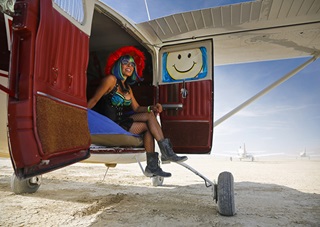
Now, after 19 visits, she's nearly perfected desert airplane camping. Her gear is stored neatly in plastic bins, daily costumes are laid out in sequence, and the Cessna 206 also serves as her apartment. She even brings a pair of bicycles, an inflatable mattress, and a portable generator for heating and cooling.
"It takes me three full days to organize and pack the airplane for Burning Man," she said. "You can't just throw it all together at the last minute."
The event has changed dramatically as it's grown. But SkyChick said the things that keep her coming back are the friendships she renews with fellow pilots and the astonishing creativity on display every day.
"The combination of the people and the art is just totally unique in my experience," she said. "There's no greater concentration of creativity anywhere in the world than right here."
Dawn departure
My favorite time of each day here is dawn.
The pandemonium has settled down, the air is brisk and still, and the desert is silent. The sky lights up as I drink a cup of coffee and plan for departure.
I packed my bags the night before, and the dust squeaks with each footstep as I carry the bulky gear to our airplane. Peeling back the plastic wrap that covers its skin goes quickly, and in 15 minutes I've collected it all into a beach ball-sized wad. I brought a box of 30 heavy duty garbage bags, and everything that goes into the airplane, trash included, is first stuffed into one. Backpacks, tents, boots, water bottles—everything. I even put garbage bags over the seats to protect them from Rose and me.
Rose makes use of this last bit of golden morning light for photography as I perform a detailed preflight inspection. Rose climbs in and closes the door, and we crank up and taxi to the departure runway. The threshold is a half-mile away from our tie down, so the oil is warm by the time we get there.
A soft-field takeoff gets us off the ground in a little more than 1,000 feet, and the airplane accelerates smoothly in ground effect. The departure procedure requires staying below 500 feet agl for three miles, and that’s fine with me. It feels good to be moving quickly again after days as a pedestrian.
The air is cool and smooth, and I turn toward Winnemucca, Nevada, where we'll fill the tanks and I'll give the airplane a proper cleaning. On the way out, I see the Frog Pond. It's a brown blotch right where Squeeze Box said it would be, and it's so prominent I can't believe I missed it on the way in.
We climb to 9,500 feet msl and check in with ATC for flight following. We’ve re-entered the real world already.
Rose and I compare notes on our time at Burning Man.
"Some guy this morning was saying how this place just speaks to his soul." Rose said. "All I could think was this guy's soul is in a completely different place than mine. I couldn't wait to leave. I'm really looking forward to my next shower—and air conditioning."
I couldn’t help but compare this desert camping experience to my last one in Iraq where, almost a decade ago, I had been a news reporter traveling with the U.S. Army. Both involved harsh weather and sleep deprivation—but at least there were no mortars or IEDs in Nevada.
SkyChick, who has flown to and from this event more than anyone, said she tires of people who think they know all about Burning Man but have never been here.
“They'll tell you it's a hippie convention," she said. "They'll tell you it's a celebrity hang out. The truth is they really don't know, and they can't know without actually being here. And everyone who does come here has a different experience. What people tell you about this place is more of a reflection on them than a window into what really goes on here. It's a mirror."
Or a mirage.

